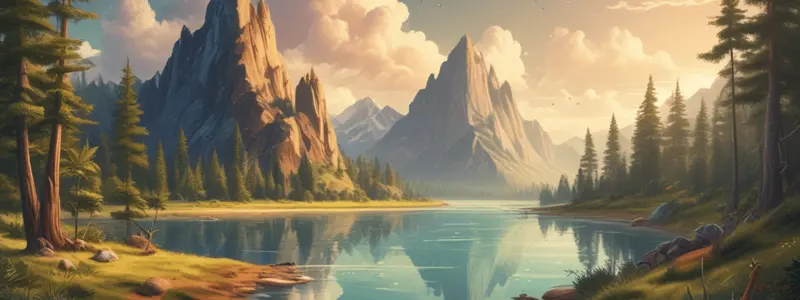Podcast
Questions and Answers
What is the environment referred to?
What is the environment referred to?
- All living things that surround us
- Only natural components that surround us
- All non-living things that surround us
- All living and non-living things that surround us (correct)
What is the cultural environment composed of?
What is the cultural environment composed of?
- Human-made structures, natural systems, and cultural values
- Atmosphere, hydrosphere, and lithosphere
- Biosphere, ecosystems, and food chains
- Human-made structures, social systems, and cultural values (correct)
What is an example of an ecosystem?
What is an example of an ecosystem?
- A single living organism
- A forest (correct)
- A mountain range
- A community of living organisms
What is the main purpose of food chains and webs?
What is the main purpose of food chains and webs?
What is an example of air pollution?
What is an example of air pollution?
What is the main goal of conservation?
What is the main goal of conservation?
What is the result of population growth?
What is the result of population growth?
What is an example of resource depletion?
What is an example of resource depletion?
What is the main principle of sustainable development?
What is the main principle of sustainable development?
What is the impact of climate change on ecosystems?
What is the impact of climate change on ecosystems?
Flashcards are hidden until you start studying
Study Notes
Environment Definition
- The environment refers to all living and non-living things that surround us, including air, water, land, and living organisms.
- It is the external surroundings in which we live, including natural and cultural components.
Components of the Environment
- Natural Environment:
- Atmosphere (air)
- Hydrosphere (water)
- Lithosphere (land)
- Biosphere (living organisms)
- Cultural Environment:
- Human-made structures and infrastructure
- Social and economic systems
- Cultural values and beliefs
Environmental Systems
- Ecosystems:
- Interconnected communities of living and non-living components
- Examples: forests, oceans, deserts, coral reefs
- Food Chains and Webs:
- Networks of predator-prey relationships
- Show energy flow through ecosystems
Environmental Issues
- Pollution:
- Air pollution (e.g., smog, acid rain)
- Water pollution (e.g., oil spills, industrial waste)
- Land pollution (e.g., litter, toxic waste)
- Climate Change:
- Global warming and cooling trends
- Impact on ecosystems and human societies
- Conservation:
- Protecting and preserving natural resources
- Sustainable use and management of resources
Human Impact on the Environment
- Population Growth:
- Increasing demand on resources
- Strain on ecosystems and infrastructure
- Resource Depletion:
- Overfishing, deforestation, and habitat destruction
- Unsustainable use of natural resources
- Sustainable Development:
- Meeting present needs without compromising future generations' ability to meet their own needs.
Environment Definition
- The environment encompasses all living and non-living things surrounding us, including air, water, land, and living organisms.
Components of the Environment
- Natural Environment:
- Comprises the atmosphere, hydrosphere, lithosphere, and biosphere
- Cultural Environment:
- Includes human-made structures, infrastructure, social and economic systems, and cultural values and beliefs
Environmental Systems
- Ecosystems:
- Interconnected communities of living and non-living components, such as forests, oceans, deserts, and coral reefs
- Exhibit a delicate balance between biotic and abiotic factors
- Food Chains and Webs:
- Represent networks of predator-prey relationships, demonstrating energy flow through ecosystems
- Can be complex and involve multiple trophic levels
Environmental Issues
- Pollution:
- Air pollution: smog, acid rain, and other hazardous gases
- Water pollution: oil spills, industrial waste, and sewage
- Land pollution: litter, toxic waste, and contaminated soil
- Climate Change:
- Global warming and cooling trends, impacting ecosystems and human societies
- Consequences include rising sea levels, altered weather patterns, and biodiversity loss
- Conservation:
- Involves protecting and preserving natural resources for future generations
- Requires sustainable use and management of resources
Human Impact on the Environment
- Population Growth:
- Exacerbates demand on resources, straining ecosystems and infrastructure
- Accelerates environmental degradation and resource depletion
- Resource Depletion:
- Overfishing, deforestation, and habitat destruction threaten ecosystem integrity
- Unsustainable use of natural resources compromises long-term availability
- Sustainable Development:
- Aims to meet current needs without compromising the ability of future generations to meet their own needs
- Requires balancing economic, social, and environmental considerations
Studying That Suits You
Use AI to generate personalized quizzes and flashcards to suit your learning preferences.




